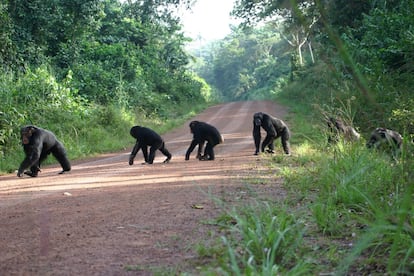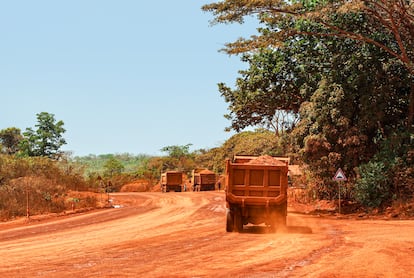Need for critical minerals threatens Africa’s great apes
Chimpanzee and gorilla habitats are located close to operational and preoperational mining areas for materials that are essential for key technologies and the green energy transition

A total of 178,816 great apes, 34% of those left in Africa, live in areas that are near a mine or close to one that is planned to open. The most affected populations are in the western and central regions of the continent, where the majority of chimpanzees and western gorillas are concentrated. Many of the mines are for what are known as critical minerals, due to their key role in the green energy transition.
In 2020, researchers estimated the global area affected by land mining at 50 million km², limiting the impact to a 19-mile (50-kilometer) radius around each mine. Most of eastern and northern Europe, the entire American Pacific belt, central, eastern and southeastern Asia and much of the Australian continent are dotted with mining operations. Africa, while the density of mining activity was much lower, has the biggest number of mining prospects and plans. In more than 80% of cases, the mines are for deposits of lithium, nickel, cobalt, graphite, manganese — all considered critical minerals given their scarcity and the key role they play in various technologies, especially those related to the production and consumption of clean energy. The African continent is home to 30% of these mining resources. The problem is that it is also in the ecoregion with the greatest biodiversity, home to 25% of mammal species and all the great apes, with the exception of the orangutan.
A large group of researchers compared the map of operation and preoperational mining with the distribution of chimpanzees, bonobos and western gorillas in 17 African countries, according to International Union for Conservation of Nature (IUCN) reports. The results, published in the journal Science Advances, show how difficiult it will be to accelerate the end of fossil fuels without further threatening Africa’s great apes, whose populations have been decimated in the last 150 years.
Three percent of the total great ape population will be within six miles (10 kilometers) of a mining facility. According to the study, at this distance, the population would be directly affected by the mine due to habitat destruction, chemical, light and noise pollution and increased risk of exposure to disease. The research also estimates the damage from indirect impacts, such as the fragmentation of the population’s territory. Another big impact is the development of roads and railways, which lead to other harmful effects, such as increased human density, logging and agriculture. A paper published in 2021 showed how the negative consequences of a new road were felt by the chimpanzee populations up to 10.6 miles (17 kilometers) away. In this new study, the extent of the damage was limited to a 19-mile radius around the mining facility. One third of the African great apes live within this range.

Traditional and better studied threats, such as hunting, logging and agriculture, were considered the main dangers. But for Jessica Junker, a researcher at the conservation organization Re:wild and the lead author of the study, the impact of mining is being undervalued. And it is felt far beyond those six miles.
“Studies with other species suggest that it harms apes through pollution, habitat loss, increased hunting pressure and diseases, but this image is incomplete,” she says. As early as the exploratory phase, drilling noise and detonations disturb the communities. Metal contamination of water, road accidents and the high risk of exposing the animals to an infectious disease they are not prepared for are factors that also have an impact, even if they are difficult to quantify. “The lack of data sharing by mining projects hampers our scientific understanding of their true impact on great apes and their habitat,” adds Junker, who began the study while completing her graduate studies at the German Center for Integrative Biodiversity Research (iDiv) Halle-Jena-Leipzig.
Chinese opacity
By region, chimpanzees in West Africa are the worst affected. The mining areas of five of the eight countries in the area overlap with the animal’s last refuges. The most extreme case is Guinea, the country with the world’s third-largest reserves of bauxite (a source of aluminum). Eighty-three percent of the 23,000 chimpanzees in West Africa live in areas of mining interest. In Cameroon, Congo, Equatorial Guinea and Gabon, 29% of great apes live in an area affected by an operational or preoperational mine. While in the east of the continent (Tanzania, Rwanda, Burundi and Uganda), where the populations are smaller in size, the figure is 62%. “There are more mining projects in West Africa than in Central or East Africa. So, proportionally, the greatest overlap between mining areas and great apes occurs there,” explains Junker. “However, in central Africa, a much larger number of animals could be affected, as ape densities are generally higher.”
The researchers warn that the data in the study does not present the whole picture. The research does not include complete figures from the Democratic Republic of the Congo, the largest country in Africa after Algeria. Up to 40% of chimpanzees, the only bonobo populations, and subspecies of mountain gorilla and eastern lowland gorillas are concentrated in its jungles. But, although there is information on the operational and preoperational mines in the country — most of which have been launched by Chinese companies — the researchers were not able to obtain reliable data on the geographical distribution of the apes. Another issue that was not included in the analysis was artisan mining, which takes a heavy toll on the protected areas. By focusing the study on Africa, the researchers have left out the other great ape, the orangutan. But previous works have shown how mining, after deforestation to make way for agriculture, has led to a decline in orangutan populations.
More than 84% of the mining areas analyzed were mineral exploration areas, meaning the damage could still be mitigated. Ideally, Junker says, “priority should be given to mining projects outside ape habitats. What is feasible, however, would be for mining companies to lengthen their mitigation plans both in time and geographically. Typically, they do not go beyond offsetting the impact beyond 10 kilometers and their plans do not last more than a decade. But reality does not match wishful thinking.”
Tenekwetche Sop, the head of the ape database at the Senckenberg Museum of Natural History (Germany) and senior author of the paper, stresses that “companies operating in these areas should have proper mitigation and compensation plans in place to minimize their impact, which seems unlikely, given that most lack robust baseline data on species required to inform these actions.”
Sign up for our weekly newsletter to get more English-language news coverage from EL PAÍS USA Edition
Tu suscripción se está usando en otro dispositivo
¿Quieres añadir otro usuario a tu suscripción?
Si continúas leyendo en este dispositivo, no se podrá leer en el otro.
FlechaTu suscripción se está usando en otro dispositivo y solo puedes acceder a EL PAÍS desde un dispositivo a la vez.
Si quieres compartir tu cuenta, cambia tu suscripción a la modalidad Premium, así podrás añadir otro usuario. Cada uno accederá con su propia cuenta de email, lo que os permitirá personalizar vuestra experiencia en EL PAÍS.
¿Tienes una suscripción de empresa? Accede aquí para contratar más cuentas.
En el caso de no saber quién está usando tu cuenta, te recomendamos cambiar tu contraseña aquí.
Si decides continuar compartiendo tu cuenta, este mensaje se mostrará en tu dispositivo y en el de la otra persona que está usando tu cuenta de forma indefinida, afectando a tu experiencia de lectura. Puedes consultar aquí los términos y condiciones de la suscripción digital.
More information
Archived In
Últimas noticias
Pinochet’s victims grapple with José Antonio Kast’s rise in Chile
Reinhard Genzel, Nobel laureate in physics: ‘One-minute videos will never give you the truth’
From digital curfews to blocking apps: How technology experts protect their children online
Why the price of coffee has skyrocketed: from Brazilian plantations to specialty coffee houses
Most viewed
- Pablo Escobar’s hippos: A serious environmental problem, 40 years on
- Why we lost the habit of sleeping in two segments and how that changed our sense of time
- Trump’s obsession with putting his name on everything is unprecedented in the United States
- Charles Dubouloz, mountaineering star, retires at 36 with a farewell tour inspired by Walter Bonatti
- The Florida Keys tourist paradise is besieged by immigration agents: ‘We’ve never seen anything like this’











































